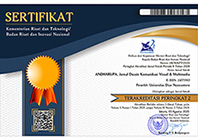Representasi Anti Diskriminasi pada Film Kartun 3D Zootopia (Kajian Semiotika Roland Barthes)
DOI:
https://doi.org/10.33633/andharupa.v2i02.1217Abstract
Isu diskriminasi SARA seperti tiada habisnya terjadi di dunia ini, begitu juga di Indonesia. Hal ini mengakibatkan tema-tema tentang SARA menjadi sensitif ketika dibahas atau pun difilmkan. Hal ini mengakibatkan jarang ditemui film yang mengangkat tentang SARA. Lain halnya dengan Walt Disney. Walt Disney baru-baru ini merilis film kartun 3D yang mengangkat tema anti diskriminasi SARA yang berjudul Zootopia. Film ini menjadi menarik karena isu diskriminasi SARA yang diangkat dibalut dengan konsep yang kreatif hingga sensivitas isu SARA tersebut menjadi berkurang. Representasi anti diskriminasi SARA pada film Zootopia ini selanjutnya dikaji dengan metode semiotika Roland Barthes dengan pendekatan deskriptif kualitatif. Berdasarkan dari analisis, dapat disimpulkan bahwa film Zootopia memuat pesan ideologi tentang anti diskriminasi SARA bahwa kedudukan manusia dimata manusia yang lain pada hakikatnya adalah sama. Setiap manusia berhak dan wajib memperlakukan dan diperlakukan secara bijak tanpa memperdulikan background asal manusia itu sendiri. Penghargaan pada setiap individu tidak didasarkan pada faktor keturunan, ras, suku ataupun agama, namun didasarkan pada prestasi dari individu itu sendiri. Kata Kunci: diskriminasi SARA, Zootopia, Roland Barthes  AbstractThe issue of racial discrimination as an endless happen in this world, so also in Indonesia. This resulted in the themes of SARA be sensitive when discussed or filmed. This resulted in a rare film that raised about SARA. Another case with Walt Disney. Walt Disney recently released 3D animated film that mengangat theme of anti-discrimination SARA entitled Zootopia. This film is interesting because racial discrimination issues raised wrapped with a creative concept to the sensitivity of the racial issues be reduced. SARA anti-discrimination representation on film Zootopia is further studied with Roland Barthes semiotic methods with qualitative descriptive approach. Based on the analysis, it can be concluded that the film contains Zootopia ideology of anti-discrimination message SARA that the position of human eyes of another human being is essentially the same. Every human being is entitled and obliged to treat and be treated wisely, regardless of the origin of man's own background. On each individual award is not based on heredity, race, ethnicity or religion, but is based on the achievements of the individuals themselves.Keywords: racial discrimination, Zootopia, Roland BarthesReferences
Duffy, K.G., Wong, F.Y. 1996. Community Psychology. Boston: Allyn & Bacon.
Kasali, Rhenald. 2007. Manajemen Periklanan Konsep dan Aplikasi. Jakarta: Pustaka Utama Grafiti.
Kurniawan. 2001. Semiologi Roland Barthes. Mangelang: Indonesiatera.
Piliang, Yasraf Amir. 2004. “Metode Penelitian Desain: Berbagai Kecenderungan Masa Kiniâ€. Jurnal Seni Rupa dan Desain, FSRD Untar Jakarta VI/2
Putra, Dedy Kusuma. 2014. Representasi Perempuan Dewasa Yang Terbelenggu Dalam Tayangan Iklan Televisi. Universitas Atma Jaya Yogyakarta.
Marcel, Danesi. 2010. Pesan, tanda dan Makna, Buku Teks Dasar Mengenai Semiotika dan Teori Komunikasi. Yogyakarta: Jalasutra.
Sasongko G., Setiawan. 2005. Kartun Sebagai media Dakwah. Jakarta: Sigma Digi Media.
Sinaga, E.C., Wiranata, I Made, Dewi, P.R.K., 2014. Upaya Uni Eropa dalam Mempromosikan Integrasi Sosial Etnis Roma Di Rumania (2010-2014). Bali.
Sugiyono. 2005. Metode Penelitian Administrasi. Bandung: Alfabeta.
Sutanto, T. 2005. “Sekitar Dunia Desain Grafis / Komunikasi Visualâ€. Pura-pura Jurnal DKV ITB Bandung. 2/Juli
Tinarbuko, Sumbo. 2001. “Semiotika Desain Dagadu Djokdjaâ€. Yogyakarta: Dagadu For Beginers Pakuningratan.
Vera, Nawiroh. 2014. Semiotika dalam Riset Komunikasi. Bogor: Galia Indonesia.
http://www.bbc.com/indonesia/dunia/2015/05/150501_polisi_temuan_baltimore
http://bahasa.kemdiknas.go.id/kbbi/ diakses pada 28 Juli 2016
http://news.okezone.com/read/2015/10/19/337/1234077/setahun-rezim-jokowi-jk-meletus-100-kasus-sara
Downloads
Published
Issue
Section
License
Copyright (c) 2016 ANDHARUPA: Jurnal Desain Komunikasi Visual & Multimedia

This work is licensed under a Creative Commons Attribution 4.0 International License.
Authors who publish with this journal agree to the following terms:
- Authors retain copyright and grant the journal right of first publication with the work simultaneously licensed under a Creative Commons Attribution License that allows others to share the work with an acknowledgment of the work's authorship and initial publication in this journal.
- Authors are able to enter into separate, additional contractual arrangements for the non-exclusive distribution of the journal's published version of the work (e.g., post it to an institutional repository or publish it in a book), with an acknowledgment of its initial publication in this journal.
- Authors are permitted and encouraged to post their work online (e.g., in institutional repositories or on their website) prior to and during the submission process, as it can lead to productive exchanges, as well as earlier and greater citation of published work (See The Effect of Open Access).















